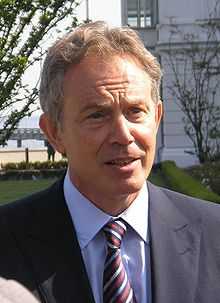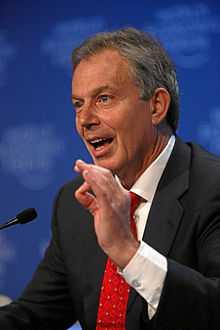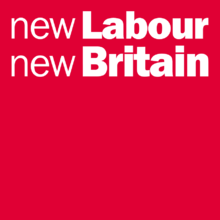Blair ministry
| 88th Cabinet of the United Kingdom (since 1707) | |
| 1997–2007 | |
 | |
| Date formed | 1 May 1997 |
|---|---|
| Date dissolved | 24 June 2007 |
| People and organizations | |
| Head of government | Tony Blair |
| Deputy head of government | John Prescott |
| Head of state | Elizabeth II |
| Number of ministers | 25 (in and attending cabinet) |
| Member party | Labour Party |
| Opposition party | Conservative Party |
| Opposition leader |
|
| History | |
| Election(s) | |
| Previous | Major ministry |
| Successor | Brown ministry |
The Blair ministry was formed by Tony Blair in May 1997 after being invited by Queen Elizabeth II to form a new government following the resignation of the previous Prime Minister of the United Kingdom, John Major as a result of the Labour Party victory in the 1997 General Election. He would serve as the Prime Minister for three successive parliamentary terms until the year 2007. His Cabinet was reshuffled for each new parliament along with a few minor changes during each term.
Formation
After 18 years in opposition, Labour ousted the Tories in the May 1997 election with a 179-seat majority. The Prime Minister Tony Blair, who turned 44 just days after leading Labour to power, was the youngest Prime Minister of the 20th century.
Blair quickly wiped away memories of the troubled Labour governments led by Harold Wilson and James Callaghan as the economic recovery continued and unemployment continued to fall. While other developed countries, notably Japan, were hit by a financial crisis during Blair's first term in office, Britain's economy remained strong.
In September 2000, however, protests against fuel prices intensified across the country and the new Tory leader William Hague exploited the situation by pointing out to voters just how much fuel prices had risen under Labour. This sparked a brief Tory lead in the opinion polls – the first in eight years – but once the protests and consequent fuel shortages ended, Labour led the opinion polls once more. Blair was so confident of re-election that he called a general election for 3 May, but this was postponed until 7 June due to the foot and mouth crisis. This led to a brief crisis in the agricultural and tourism industries, but did little to shake a still-strong economy and the voters responded by re-electing Blair with an only slightly reduced majority.
Tory leader William Hague, whose party barely improved on their disastrous election result of 1997, stepped down after the election and was succeeded by Iain Duncan Smith.
Following the financial crisis in Japan at the end of the 1990s, there was a brief recession in other parts of the developed world including Germany,[1] Italy and France in the early 2000s, but once again Britain avoided recession and continued to enjoy a strong economy and low unemployment.[2]
By the time the next general election was on the horizon, Blair and Labour were looking well positioned for a record third successive term in government. Unemployment remained low and the economy remained strong with more than a decade of unbroken growth, and education and healthcare had changed for the better as a result of expenditure by Labour.
However, the Labour government had attracted controversy by sending British troops to fight in Afghanistan in the aftermath of the 11 September terrorist attacks on the United States in 2001, and even more so when it joined the American-led invasion of Iraq 18 months later – particularly when it emerged that the ousted Iraqi leader Saddam Hussein's alleged nuclear weapons were never found and serious questions were raised about the issue of going to war. Although the dictatorship regimes in both of these countries were swiftly ended by British and American troops, the remaining British forces were not withdrawn from Iraq until 2009 and from Afghanistan until 2014.
Soon after the invasion of Iraq, Labour support in the opinion polls fell and the Tories drew level with them in at least one poll during 2003. However, this did little to end speculation about the future of their unpopular leader Iain Duncan Smith and in October 2003 he lost a vote of no confidence and was replaced by Michael Howard, who stood unopposed for the leadership role and took control without a leadership contest.
The election on 5 May 2005 saw Labour win their historic third successive term in power, though their majority now stood at 66 seats – compared to 167 four years earlier – and they failed to gain any new seats. Blair had already declared that the new term in parliament would be his last.
Fate
Blair remained as Prime Minister and Labour Party leader for a further two years, stepping down on 24 June 2007 and being succeeded by Chancellor Gordon Brown.
By this stage, Labour's days in government were starting to look numbered. Initially it seemed that Blair's decision to step down as the Labour Party leader was a tactical move to help boost Labour's chances of a fourth successive election win but it soon transpired that through a coup conducted by rebel Labour MPs and members, he had been given no choice but to stand down as leader. His authority had been called into question and he had been checkmated. David Cameron had been elected to the Tory leadership in December 2005, and since then the opinion polls had shown Labour lose the lead to the Tories and regain it several times.
Cabinets
These are the cabinets under Prime Minister Tony Blair (from May 1997 to June 2007).
May 1997 to June 2001
- Tony Blair – Prime Minister, First Lord of the Treasury, and Minister for the Civil Service
- John Prescott – Deputy Prime Minister and Secretary of State for the Environment, Transport and the Regions
- Gordon Brown – Chancellor of the Exchequer and Second Lord of the Treasury
- The Lord Irvine of Lairg – Lord Chancellor
- Ann Taylor – Lord President of the Council & Leader of the House of Commons
- The Lord Richard – Lord Privy Seal & Leader of the House of Lords
- Alistair Darling – Chief Secretary to the Treasury
- David G. Clark – Chancellor of the Duchy of Lancaster and Cabinet Office Minister
- Robin Cook – Secretary of State for Foreign and Commonwealth Affairs
- Jack Straw – Secretary of State for the Home Department
- Jack Cunningham – Minister of Agriculture, Fisheries and Food
- Frank Dobson – Secretary of State for Health
- George Robertson – Secretary of State for Defence
- Harriet Harman – Secretary of State for Social Security and Minister for Women
- David Blunkett – Secretary of State for Education and Employment
- Margaret Beckett – Secretary of State for Trade and Industry and President of the Board of Trade
- Chris Smith – Secretary of State for Culture, Media and Sport
- Clare Short – Secretary of State for International Development
- Mo Mowlam – Secretary of State for Northern Ireland
- Donald Dewar – Secretary of State for Scotland
- Ron Davies – Secretary of State for Wales
- Gavin Strang – Minister for Transport
Also attending Cabinet:
- Nick Brown – Chief Whip
- John Morris – Attorney General
Changes
- July 1998 – Margaret Beckett becomes Lord President of the Council and Leader of the House of Commons. Baroness Jay of Paddington becomes Lord Privy Seal, Leader of the House of Lords and Minister for Women. Stephen Byers becomes Chief Secretary to the Treasury. Ann Taylor becomes Chief Whip, which is now a cabinet position. Jack Cunningham becomes Cabinet Office Minister and Chancellor of the Duchy of Lancaster. Nick Brown becomes Agriculture Minister. Alistair Darling becomes Social Security Secretary. Peter Mandelson enters the cabinet as Trade & Industry Secretary. John Reid becomes Transport Minister, which is no longer a cabinet position (although Dr Reid will continue attending cabinet meetings). Lord Richard, Harriet Harman, David G. Clark, and Gavin Strang leave the cabinet. The President of the Board of Trade is no longer a title used by the Trade Secretary.
- October 1998 – Alun Michael becomes Welsh Secretary. Ron Davies leaves the Cabinet.
- December 1998 – Peter Mandelson resigned from the cabinet over the Hinduja affair. Stephen Byers becomes Trade & Industry Secretary. Alan Milburn becomes Chief Secretary to the Treasury.
- May 1999 – John Reid becomes Scottish Secretary. Donald Dewar leaves the cabinet.
- July 1999 – Paul Murphy becomes Welsh Secretary. Alun Michael leaves the cabinet.
- October 1999 – Andrew Smith becomes Chief Secretary to the Treasury. Geoff Hoon becomes Defence Secretary. Alan Milburn becomes Health Secretary. Peter Mandelson returns to the cabinet as Northern Ireland Secretary. Mo Mowlam becomes Cabinet Office Minister and Chancellor of the Duchy of Lancaster. Lord Williams becomes Attorney General. John Morris, George Robertson, Jack Cunningham, and Frank Dobson leave the cabinet.
- January 2001 – Peter Mandelson resigns as Northern Ireland Secretary and is succeeded by John Reid. Helen Liddell enters the cabinet and succeeds John Reid as Scottish Secretary.
June 2001 to May 2005
- Tony Blair – Prime Minister, First Lord of the Treasury, and Minister for the Civil Service:
- John Prescott – Deputy Prime Minister and First Secretary of State
- Gordon Brown – Chancellor of the Exchequer and Second Lord of the Treasury
- The Lord Irvine of Lairg – Lord Chancellor
- Robin Cook – Lord President of the Council & Leader of the House of Commons
- The Lord Williams of Mostyn – Lord Privy Seal & Leader of the House of Lords
- Andrew Smith – Chief Secretary to the Treasury
- Jack Straw – Secretary of State for Foreign and Commonwealth Affairs
- David Blunkett – Secretary of State for the Home Department
- Margaret Beckett – Secretary of State for Environment, Food and Rural Affairs
- Stephen Byers – Secretary of State for Transport, Local Government and the Regions
- Alan Milburn – Secretary of State for Health
- Geoff Hoon – Secretary of State for Defence
- Alistair Darling – Secretary of State for Work and Pensions
- Estelle Morris – Secretary of State for Education and Skills
- Patricia Hewitt – Secretary of State for Trade and Industry and Minister for Women and Equality
- Tessa Jowell – Secretary of State for Culture, Media and Sport
- Clare Short – Secretary of State for International Development
- John Reid – Secretary of State for Northern Ireland
- Helen Liddell – Secretary of State for Scotland
- Paul Murphy – Secretary of State for Wales
- Charles Clarke – Minister without Portfolio and Labour Party chairman
Also attending Cabinet:
- Hilary Armstrong – Parliamentary Secretary to the Treasury and Government Chief Whip
- Lord Goldsmith: Attorney General
Changes
- May 2002 – Stephen Byers resigns and the Department of Transport, Local Government & the Regions is broken up. Alistair Darling becomes Secretary of State for Transport. John Prescott's Office of the Deputy Prime Minister assumes the Local Government & the Regions portfolio. Andrew Smith becomes Work and Pensions Secretary. Paul Boateng becomes Chief Secretary to the Treasury. Complete list of changes
- October 2002 – Estelle Morris resigns. Charles Clarke becomes Education Secretary; John Reid becomes Minister without Portfolio and Labour Party chairman. Paul Murphy becomes Northern Ireland Secretary. Peter Hain becomes Welsh Secretary.
- March 2003 – Robin Cook resigns. John Reid becomes Lord President of the Council & Leader of the House of Commons. Ian McCartney becomes Minister without Portfolio and Labour Party chairman.
- May 2003 – Clare Short resigns and is succeed by Baroness Amos as International Development Secretary.
- June 2003 – In a reshuffle John Reid becomes Health Secretary. Lord Falconer of Thoroton assumes the new position of Secretary of State for Constitutional Affairs, also becoming Lord Chancellor. Alistair Darling becomes Scottish Secretary remaining also Transport Secretary. Peter Hain becomes Lord Privy Seal & Leader of the House of Commons, remaining also Welsh Secretary. Alan Milburn, Lord Irvine of Lairg, and Helen Liddell leave the Cabinet. Complete list of changes
- October 2003 – Baroness Amos becomes Lord President of the Council & Leader of the House of Lords, following the death of Lord Williams of Mostyn. Hilary Benn becomes International Development Secretary.
- September 2004 – Andrew Smith resigns as Secretary of State for Work and Pensions and is succeeded by Alan Johnson. Alan Milburn returns to government with a seat in the Cabinet as Chancellor of the Duchy of Lancaster mainly at the head of policy co-ordination; he replaces Douglas Alexander, who was not in the Cabinet.
- December 2004 – David Blunkett resigns as Home Secretary and is succeeded by Charles Clarke. Ruth Kelly succeeds Clarke as Secretary of State for Education and Skills.
May 2005 to June 2007
- Tony Blair – Prime Minister, First Lord of the Treasury, and Minister for the Civil Service:
- John Prescott – Deputy Prime Minister and First Secretary of State
- Gordon Brown – Chancellor of the Exchequer and Second Lord of the Treasury
- The Lord Falconer of Thoroton – Secretary of State for Constitutional Affairs and Lord Chancellor
- Charles Clarke – Home Secretary
- Jack Straw – Secretary of State for Foreign and Commonwealth Affairs
- Geoff Hoon – Leader of the House of Commons and Lord Privy Seal
- The Baroness Amos – Leader of the House of Lords and Lord President of the Council
- Tessa Jowell – Secretary of State for Culture, Media and Sport and Minister for the Olympics
- John Reid – Secretary of State for Defence
- Ruth Kelly – Secretary of State for Education and Skills
- Margaret Beckett – Secretary of State for Environment, Food and Rural Affairs
- Patricia Hewitt – Secretary of State for Health
- Hilary Benn – Secretary of State for International Development
- Peter Hain – Secretary of State for Northern Ireland and Secretary of State for Wales
- Alan Johnson – Secretary of State for Trade and Industry
- Alistair Darling – Secretary of State for Transport and Secretary of State for Scotland
- David Blunkett – Secretary of State for Work and Pensions
- John Hutton – Chancellor of the Duchy of Lancaster (Cabinet Office)
- Des Browne – Chief Secretary to the Treasury
- Ian McCartney – Minister Without Portfolio and Party Chair
Also attending Cabinet:
- David Miliband – Minister of State for Communities and Local Government
- Hilary Armstrong – Parliamentary Secretary to the Treasury and Government Chief Whip
Changes
- November 2005 – David Blunkett resigns his post as Secretary of State for Work and Pensions. He is replaced by John Hutton, leaving the post of Chancellor of the Duchy of Lancaster vacant for six months.
- May 2006 – Following a poor showing in the local council elections, Blair reshuffles his cabinet. Charles Clarke, Geoff Hoon, and Ian McCartney leave the Cabinet. Jack Straw becomes Leader of the House of Commons and Lord Privy Seal. Margaret Beckett is promoted to Foreign Secretary, John Reid to Home Secretary, David Miliband to Secretary of State for the Environment, Food and Rural Affairs, and Des Browne to Secretary of State for Defence. Ruth Kelly takes a new post of Secretary of State for Communities and Local Government, which replaces the post held by David Miliband and takes a number of responsibilities previously held by the Office of the Deputy Prime Minister; Kelly will also serve as Minister for Women and Equality. Alan Johnson becomes Secretary of State for Education and Skills. Alistair Darling becomes Secretary of State for Trade and Industry. Hilary Armstrong becomes Chancellor of the Duchy of Lancaster, Minister for the Cabinet Office and Minister for Social Exclusion. Douglas Alexander enters the Cabinet as Secretary of State for Transport and Secretary of State for Scotland. Hazel Blears enters the Cabinet as Minister Without Portfolio and Party Chair, Stephen Timms as Chief Secretary to the Treasury, and Jacqui Smith as Parliamentary Secretary to the Treasury and Chief Whip.
- May 2007 – The Home Office loses responsibility for criminal justice, prisons & probation and legal affairs which merges into the Department for Constitutional Affairs with Lord Falconer becoming Secretary of State for Justice.
References
- ↑ "Germany's recession ends". BBC News. 23 May 2002.
- ↑ "French economy in trouble". BBC News. 20 August 2003.
- General
- D. Butler and G. Butler (ed.). Twentieth Century British Political Facts 1900–2000.
External links
- The Public Whip – Ministerial Whirl tool showing Tony Blair's Cabinet changes since 1997 (java applet)
| Preceded by Major ministry |
Government of the United Kingdom 1997–2007 |
Succeeded by Brown ministry |
| ||||||||||||||||||||||||||||||||||||||||||||||||||||||
| |||||||||||||||||||||||||||||||||
.svg.png)

